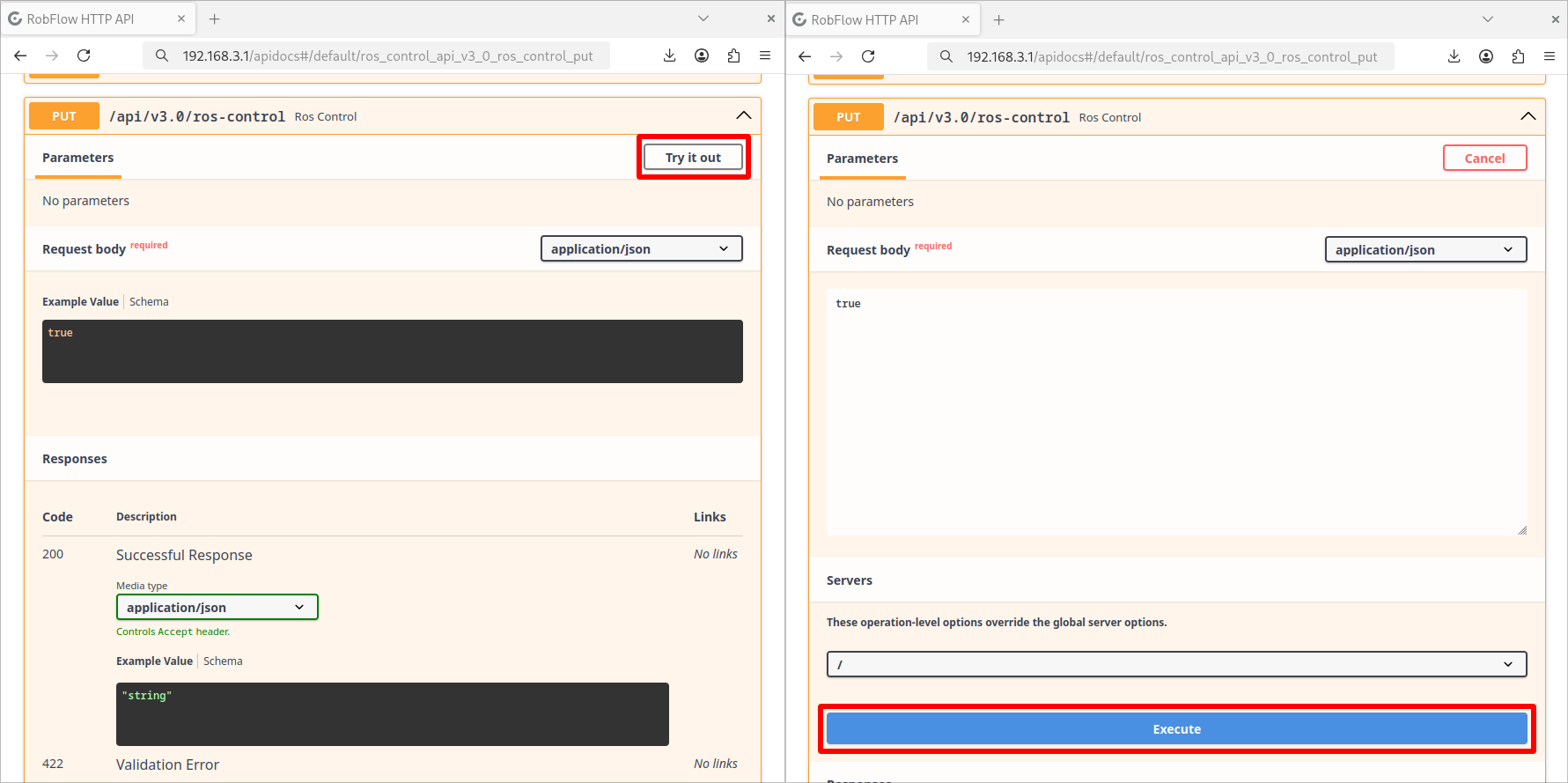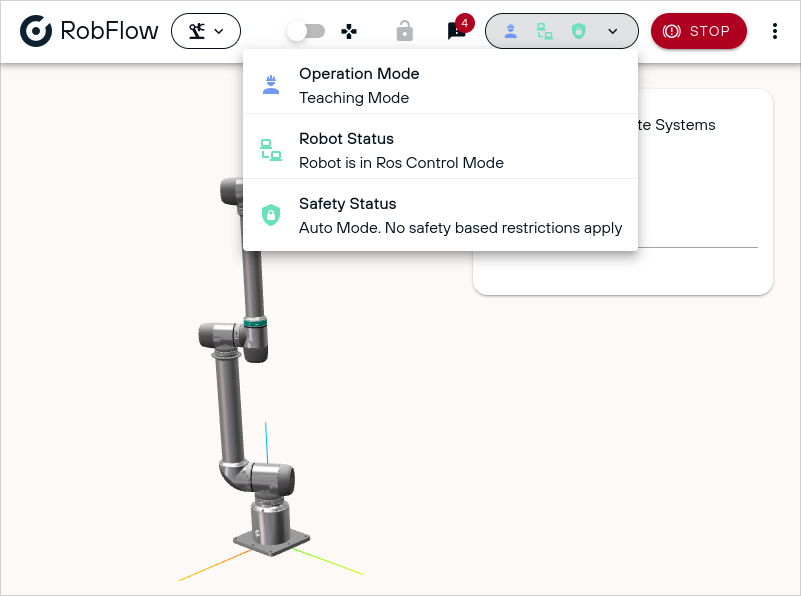Using the hardware interface
The robco_hardware package supplies a ros2_control hardware interface, allowing
ros2_control controllers to interface with RobCo robots.
The following command interfaces are supported:
effort: robot accepts torque commandsposition,velocityandacceleration: all three of these command interfaces must be active at the same time, used for trajectory streaming
Configuring the hardware interface
Note
Using the hardware interface requires a URDF file to describe the robot. Refer to Creating a URDF file for instructions on how to create one, then update the launch file mentioned below to load the correct file for your particular robot configuration.
Attention
The launch files and configurations provided as part of the robco_bringup package are for an
exemplary robot configuration and should be used as a basis for creating files for your specific
robot configuration. Due to the modular nature of RobCo robots, a generic configuration applying
to all configurations cannot be provided.
An example launch file (robco_controller.launch.py) is provided in the robco_bringup
package. For the hardware interface to operate correctly, ensure that:
the launch file refers to the correct URDF file
the URDF file matches the robot configuration and contains the
ros2_controlconfigurationthe configuration in
robco_bringup/config/controllers.yamlis correct
To make the launch file load a different URDF file, it can be modified or copied into a separate package.
For adapting the URDF file to a specific robot configuration and configuring it for
ros2_control, see Creating a URDF file.
The controllers.yaml file is passed to the ros2_control controller manager to configure all
controllers being started. The following is an example configuration:
controller_manager:
ros__parameters:
update_rate: 1000
joint_state_broadcaster:
type: joint_state_broadcaster/JointStateBroadcaster
robco_controller:
type: joint_trajectory_controller/JointTrajectoryController
robco_controller:
ros__parameters:
joints:
- joint0_joint
- joint1_joint
- joint2_joint
- joint3_joint
- joint4_joint
- joint5_joint
command_interfaces:
- position
- velocity
- acceleration
state_interfaces:
- position
- velocity
#interpolation_method: 'none'
gains:
joint0_joint: { p: 100.0, d: 0.0, i: 1.0 }
joint1_joint: { p: 100.0, d: 0.0, i: 1.0 }
joint2_joint: { p: 100.0, d: 0.0, i: 1.0 }
joint3_joint: { p: 100.0, d: 0.0, i: 1.0 }
joint4_joint: { p: 100.0, d: 0.0, i: 1.0 }
joint5_joint: { p: 100.0, d: 0.0, i: 1.0 }
To adapt this configuration to a new robot, ensure that the joint names match those from the URDF
file. Note that the joint macros append _joint to the names of drive modules to form
the names of the actual URDF joint elements! Thus, if the drive module has name="joint2", the
name of the joint is joint2_joint.
Also, adjust the command_interfaces parameter for the set of command interfaces which should
be used. See Provided command interfaces for supported combinations.
Finally, there might be further controller parameters that need adjusting. For example, in the
configuration above for the JointTrajectoryController, there are gain settings for each joint.
Starting the hardware interface
ros2 launch robco_bringup robco_controller.launch.py
This launch file starts the following nodes:
controller_manager: The central node in the ros2_control frameworkrobot_state_publisher: Reads the joint states and, based on the kinematics defined in the URDF file, outputs transforms totfcontroller_managerspawner to start ajoint_state_broadcastercontroller to publish joint states received from the robotcontroller_managerspawner to start ajoint_trajectory_controller(namedrobco_controllerin the config) to execute trajectories on the robot using its command interfaces
It can act as a starting point for more complex setups.
Enabling the ROS streaming mode on the robot
RobCo robots with the ROS 2 interface enabled will publish joint states as soon as the internal
controller on the control unit has started successfully. However, write access (sending commands)
is disabled by default. To enable ROS joint commands, the robot must be put into streaming mode.
This feature is not exposed in the RobFlow UI yet, but it can be activated by sending a HTTP PUT
request to the /ros-control endpoint of the RobFlow API with the following JSON body:
true
This can be done using curl as follows, assuming the robot control unit is reachable as
192.168.3.1:
curl -X PUT -H 'Content-Type: application/json' -d 'true' http://192.168.3.1/api/v3.0/ros-control
Alternatively, this can be accomplished from a browser by navigating to
http://192.168.3.1/docs, finding the /ros-control endpoint, clicking “Try it out”, then
clicking “Execute”.

Sending the ros-control request from the RobFlow API Docs page.
The status area in the top right corner of the RobFlow UI should now show that the robot is in streaming mode:

RobFlow showing ROS streaming state
Note
Once the streaming mode is enabled, the internal controller starts observing incoming messages. If no message is received for 50 milliseconds, the streaming mode is automatically stopped and the robot decelerates to stop any movement. Thus, the hardware interface and ROS2 controllers should be started before the robot is put into streaming mode.
Using the hardware interface
The ros2_control hardware interface provided by robco_ros2 can be used in a variety of ways.
Please consult the official ros2_control documentation for more
information.
To get started with the provided launch files, rqt_joint_trajectory_controller can be used to command simple joint movements.